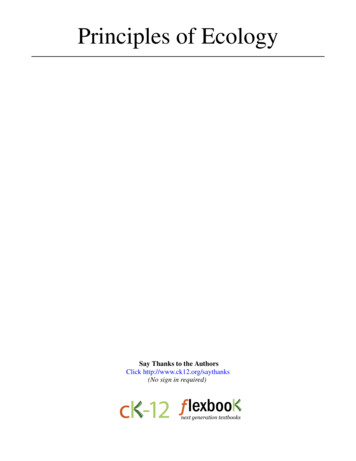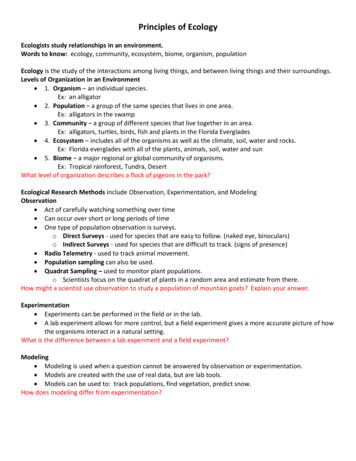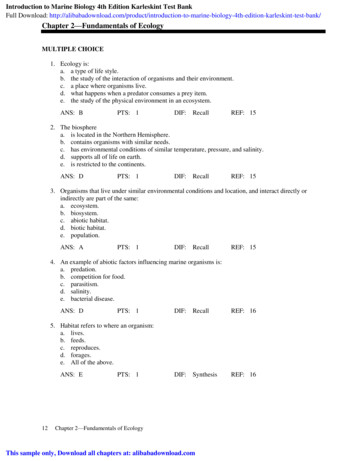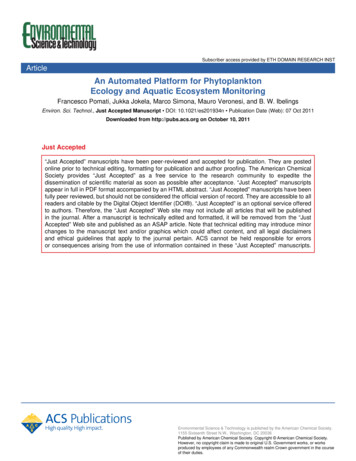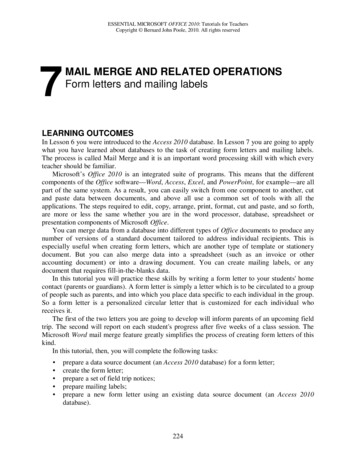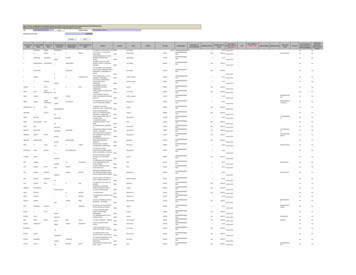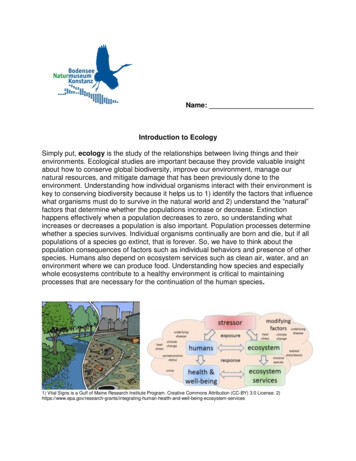
Transcription
Name:Introduction to EcologySimply put, ecology is the study of the relationships between living things and theirenvironments. Ecological studies are important because they provide valuable insightabout how to conserve global biodiversity, improve our environment, manage ournatural resources, and mitigate damage that has been previously done to theenvironment. Understanding how individual organisms interact with their environment iskey to conserving biodiversity because it helps us to 1) identify the factors that influencewhat organisms must do to survive in the natural world and 2) understand the “natural”factors that determine whether the populations increase or decrease. Extinctionhappens effectively when a population decreases to zero, so understanding whatincreases or decreases a population is also important. Population processes determinewhether a species survives. Individual organisms continually are born and die, but if allpopulations of a species go extinct, that is forever. So, we have to think about thepopulation consequences of factors such as individual behaviors and presence of otherspecies. Humans also depend on ecosystem services such as clean air, water, and anenvironment where we can produce food. Understanding how species and especiallywhole ecosystems contribute to a healthy environment is critical to maintainingprocesses that are necessary for the continuation of the human species.1) Vital Signs is a Gulf of Maine Research Institute Program. Creative Commons Attribution (CC-BY) 3.0 License. human-health-and-well-being-ecosystem-services
Levels of OrganizationEcology is defined as the scientific study of the processes influencing the distributionand abundance of organisms, and the interactions between organisms and thetransformation as well as flux of energy and matter. There are many levels at whichecologists ask questions. The largest is at the level of the biosphere. The biosphereconsists of all of the regions of the surface and atmosphere of the earth occupied byliving organisms. One step below the biosphere is the ecosystem, which consists of abiological community of interacting organisms and their physical environment. The nextlevel is the community, a group of actually or potentially interacting species living in thesame place. The next level of organization is the population, a group of interbreedingindividuals of the same species, which is isolated from other groups. The final level oforganization is the individual. An individual is any single living thing or organismdistinguished from others of the same kind.Diagram adapted from MyEnvironmentalScience.com, Pearson Education, Inc. Images are public domain in the U.S.Fill in the blank. On the line provided, fill in the level of ecological organization that thegiven example represents.1. All of the sticklebacks that live in Lake Konstanz.2. All of the biotic and abiotic components of Lake Konstanz.3. All of the species of phytoplankton that live in Lake Konstanz.4. A catfish swimming in Lake Konstanz.
Individuals: Behaviors, Niches, and Evolutionary HistoryThe relationship between ecology and evolutionary biology is important to understand.One of the most central things to consider when studying ecology is how evolutionstructures the form, function, and behaviors of organisms. The interactions thatorganisms have with each other and the environment can result in genetic changes in apopulation over time. This is called evolution. So it is important to understand howchanges happening on an ecological time scale can result in adaptations on anevolutionary time scale.Evolutionary HistoryAdaptation is defined as any alteration to the behavior, physiology, or structure of anorganism or any of its parts that results from natural selection and by which theorganism becomes better fitted to survive and multiply in its environment.Exercise. Label the following examples of adaptation as either “behavioral”, “structural”,or “physiological”.Example 1:Countercurrent heat exchange in the paws of an Eisfuchs (Alopex lagopus).Diagram adapted from Animal Physiology 2004, Sinauer Associates.
Example 2:The webbed feet of ducks that help them swim easily and quickly.Mallard: By Emily Diehl - Own work, CC BY-SA 3.0, Foot drawing: published before 1923 andis public domain in the U.S. Mallard swimming: By Michael W. Kolton (Own work), viaWikimedia CommonsExample 3:The winter migration of giant pandas. Instead of hibernating during the winter like otherspecies of bear, the giant panda moves to lower, warmer altitudes.By Rob (Flickr profile) [CC BY 2.0 (http://creativecommons.org/licenses/by/2.0)], via Wikimedia Commons.By Chen Wu from Shanghai, ChinaExercise. Provide one more example of an adaptation from each category. Walkaround the museum and take a close look at the specimens for ideas.
NichesOne of the most central concepts in ecology is that of the ecological niche. A species’ecological niche is the role and position that species has in its environment, how itmeets its needs for food and shelter, how it survives, and how it reproduces. Aspecies' niche includes all of its interactions with the biotic and abiotic factors of itsenvironment. Sometimes a species is not able to occupy its entire niche. This is oftendue to the presence or absence of other species competing for the available resources.So, we can break the concept of an ecological niche down into the fundamental nicheand the realized niche. The fundamental niche is the total potential niche a species ifno other species were using the same resources it uses, while the realized niche is theactual niche an organism occupies as a result of competition for its resources andproblems in acquiring those resources. The fundamental niche is always larger than therealized niche.
The introduction of the gray squirrel (Sciurus carolinensis) to Europe, and how thataffected the realized niche of the Red squirrel (Sciurus vulgaris) provides a goodexample of factors that can influence the realized niche of a species. The Americangray squirrel was introduced to Britain in 1876 as an ornamental species, and has sincereplaced the native red squirrel throughout most of its historical range. These speciesoccupy a similar niche. They both live in trees and feed on similar food resources. Thegray squirrel is about twice the size of the red squirrel, and live in much denserpopulations than the red squirrels. The gray squirrels have also evolved a tolerance tounpalatable chemicals produced by unripe acorns (tannins), while the red squirrels havenot. This means that the gray squirrels can eat all of the acorns early in the season,leaving the red squirrels without many food resources. All of these factors give the graysquirrels a competitive advantage over the red squirrels. This competitive advantagereduces the realized niche of the red squirrel, and may eventually cause the red squirrelto go extinct in some areas.1) By Peter Trimming [CC BY 2.0 (http://creativecommons.org/licenses/by/2.0)], via Wikimedia Commons.2) By Troydj (Own work), via Wikimedia CommonsQuestions.1) Name one way the realized niche of the red squirrel would be greater in places wherethe grey squirrel has not invaded.2) How do you think the gray squirrels became tolerant to the tannins in acorns? (Hint:where did the gray squirrels come from?)
Niche Construction is the process in which an organism actively modifies its ownand/or another organism’s evolutionary niche. This often results in an increased chanceof survival for the organism. A possible outcome of niche construction is “ecologicalinheritance”. This happens when such modifications alter natural selection pressures.The dam building activities of the Eurasian Beaver (Castor fiber) provide a greatexample of niche construction. When a beaver builds its dam and lodge it greatly altersthe local environment. These alterations have many indirect effects on other animalsand plants. These effects include changes in nutrient cycling, decomposition dynamics,additionally the structure of the riparian zone, community composition and diversity.Beavers cut down trees to build their dams, which alters the composition of the foresthabitat near the stream. The beavers cut down only the species of trees that they preferfor food and dam construction, leaving the undesirable species standing. Over time, theforest near a beaver pond becomes dominated by different species of trees than before,and the gaps left by the fallen trees are inhabited by smaller saplings and bushes andthe animal species that accompany those trees. When the beavers dam the stream itslows the movement of water and creates a pond of still water. This impoundmentdrastically alters the local hydrology and consequently the composition of the riparianzone. The pond also creates habitat for aquatic plants and animals that normally areonly found in non-flowing habitats such as lakes. This causes the animals adapted tofast flowing water to die out or to move downstream.iStockphoto.com/Steve GreerBy Hugo.arg - Jūsų darbas (own work), id 4270825
Questions.1) Can you think of any other examples of niche construction?2) How long do you think the ecological effects of the beaver dam last after the beavershave moved on?Exercise. Find another example of an organism that modifies its niche in the museum.Draw a picture of what you think the habitat would look like before and after it has beenmodified by the organism. What are the main differences? How long do you think themodifications would last in your example?
BehaviorsIndividuals are constantly interacting with other individuals within populations andcommunities. The branch of ecology that tries to understand the dynamics of theseinteractions is called behavioral ecology. Behavioral ecology focuses on how animalbehavior is influenced by ecological pressures in an evolutionary context. As discussedpreviously, genetic variation among individuals can lead to changes in a population ofindividuals (adaptation) over several generations via natural selection. Sometimes thesechanges are behavioral. There are several behavioral factors that can influence thesuccess of an individual. For example, competition for resources and mates,reproductive behaviors such as mate choice, mating systems, and parental investment,and social behaviors can all significantly impact an individual’s fitness.Competition is an interaction between organisms in which the fitness of one is loweredby the presence of another. Organisms compete for the resources they need to surviveair, water, food, and space. Competition can occur within (intraspecific) and between(interspecific) species.The interactions of the Musk Ox (Ovibos moschatus) within members of its ownspecies, and also with members of other species (caribou in our example) provide greatexamples of both intraspecific and interspecific competition.Intraspecific: During the breeding season, dominant males will fight each other foraccess to females. The fighting males will begin with a display of their horns, and thencharge each other from distances of up to 20 meters. They will continue to charge intoone another until one of them gives up. The winning male will then establish a harem of6-7 females to mate with.1) By Quartl (Own work), via Wikimedia Commons 2) By Bering Land Bridge National Preserve (Muskox BELA Two Adultsand COY by Jason Gablask), via Wikimedia Commons 3) Wild Wonders of Europe / Munier / naturepl.com
Interspecific: Both the musk ox and caribou (Rangifer tarandus) inhabit the arctictundra, and feed on plants such as grasses and sedges. These species are normallyable to coexist peacefully. The musk oxen are able to survive on poorer quality foods,and during the winter when food resources are at a minimum, the caribou migrate towooded areas and feed mostly on lichens. However, when abnormal weather conditionsreduce the amount of available food resources, these species must compete for thesame food resources.Questions.1) What resource is the musk ox competing for in the example of intraspecificcompetition?2) What resource is the musk ox competing for in the example of interspecificcompetition?Mating Systems are the way in which a group is structured in relation to sexualbehavior. With respect to animals, the term describes which males and females mate,and under which circumstances. Recognized systems include monogamy, polygamy,and promiscuity, all of which lead to different mate choice outcomes and thus thesesystems affect how sexual selection works in the species that practice them.-Monogamy Examples: Eurasian Beaver (Castor fiber). The Eurasian beaveris a monogamous species, meaning they only have a sexual relationship withone partner. Beavers begin to reproduce at about three years of age, andstay together for multiple breeding seasons. Only one adult pair per colonymates, while the other family members help take care of the young. Thepotential benefits of monogamy are extended parental care of offspring andmutual defense. This mating system likely evolves when the survival ofoffspring requires more care than one parent is able to provide and/or thecost of acquiring a mate is high.-Polygamy (Polyandry) Example: European Perch (Perca fluviatilis). TheEuropean perch is a predatory fish distributed widely throughout Europe andAsia, and can be found in Lake Constance. This species practices polyandry,a mating system where one female mates with several males. During thebreeding season, 15-25 mature males will wait in the spawning area for
females. Upon a female’s arrival, she is chased down by up to two males.The males will then prod her belly with their snouts, and she will release aribbon of eggs. The two males will then fertilize the egg ribbon, and the eggswill hatch in 8-16 days. There are many potential benefits of polyandry. Bymating with several males, a female is able to ensure that a high percentageof her eggs are fertilized. Additionally, by having multiple partners, a femalehas more potential males to help care for offspring and protect her frompredators.-Polygamy (Polygyny) Example: Musk Ox (Ovibos moschatus). The musk oxpractices polygyny, a mating system where one male mates with severalfemales. During the rutting season, mature males will fight for access tofemales. The winning male will then establish a harem of 6-7 females that hewill mate with throughout the breeding season. The females will then becomepregnant, and the herd will reassemble. The primary benefit of polygyny formales is high reproductive success, since they are able to mate with severalfemales and father all of the offspring. The primary benefit for females isaccess to resources such as food or territory that is controlled by the male.The female also receives protection for herself and any offspring.-Promiscuity Example: European Hare (Lepus europaeus). The Europeanhare is a promiscuous species, meaning that both males and females havesex frequently with different partners and are indiscriminate in their choice ofsexual partners. European hares reach sexual maturity at 6-8 months of age,and breed frequently throughout the year. A female hare can have up to threelitters in one year. One potential benefit of promiscuity is the maximization ofthe genetic diversity of the offspring. By maximizing the genetic diversity ofthe offspring, the chance of a beneficial adaptation is more likely. Highgenetic diversity can also compensate for the negative consequences ofinbreeding in small populations.Parental Care is an investment of resources provided by the parent to increase thefitness of the offspring, at the expense of the parent. This includes the time and energythe parents spend raising the offspring, as well as the risks the parents incur to protectthe offspring.Exercise. Rank the following types of organisms with what you think their general levelof parental investment is from the least to the most.Reptiles, Mammals, Birds, Arthropods, FishesWalk around the museum and find an example of an animal that provides parental care.List three ways in which it invests in the fitness of its offspring.
Kin Selection is an example of a social behavior in which organisms cooperate toincrease their own fitness. Because relatives share some proportion of the samegenetic material, they will help individuals that are closely related even when there is acost to their own survival. Helping relatives increases your ‘inclusive fitness’, or thepassing on of your genes indirectly through close relatives that share those genes. Anorganism’s inclusive fitness includes its own offspring (‘fitness’) plus the genesreproduced in other closely related offspring.The concept of kin selection explains altruistic behavior in highly social insect groups.For example, in ants and bees’ workers are sterile and have evolved to forgoreproduction so that the queen, their sister, can reproduce in social insect groups. Thisphenomenon also explains why a honeybee would sting something and sacrifice its lifeto defend the colony made up of its sisters. At first glance, it would seem that altruisticbehavior is at odds with the theory of natural selection. However, the theory of kinselection explains that this behavior can be advantageous because it still allows anorganism’s genes to be passed on not directly through its own offspring but insteadthrough the offspring of its relatives.
Populations: Growth and RegulationPopulation ecology is the study of how and why populations change over time. Bystudying the characteristics of populations, we can make predictions on how theirdynamics may change in the future. There are several practical applications ofunderstanding the dynamics of populations such as managing food stocks andrenewable resources, understanding and being able to predict outbreaks of pests anddiseases, and managing threatened or endangered species. There are several factorsthat influence how a population will grow and decline over time. These include thepopulation density, spatial distribution, sex ratios, structure, and birth and death rates.Important Definitions:Population Size: the actual number of individual organisms in a population.Population Density: the number of individual organisms per unit area or unit volume.Spatial Distribution: how a species is spatially arranged, i.e. uniform, random, orclustered.Sex Ratio: the ratio of males to females in a population.Geographic Range: the geographical area in which a species can be found.Population Growth: the increase in the number of individuals in a population.Exponential Growth: growth whose rate becomes ever more rapid in proportion to thegrowing total number or size, i.e. continuous growth.Logistic Growth: growth whose rate decreases as the population reaches carryingcapacity.Carrying Capacity: the maximum population size of the species that the environmentcan sustain indefinitely, given the food, habitat, water, and other necessities available inthe environment.
Exercise. Label each of the following graphs as either “logistic growth” or “exponentialgrowth”.Source: Boundless. “Exponential Population Growth.” Boundless Biology Boundless, 08 Aug. 2016. Retrieved 19 Feb. 2017from s.1) Which graph do you think most accurately represents the growth seen in naturalpopulations?2) What are some factors that could potentially influence population growth?
The Roe deer (Capreolus capreolus) provides a great example for examiningfluctuations in population size. The roe deer is a small species of deer that is native toEurasia. Roe deer have an estimated population size of about 15 million individuals inEurope. However, their population size has fluctuated greatly over time and throughouttheir geographic range as a result of several factors such as habitat and resourceavailability, the introduction/removal of predators, and management efforts of humans.This has led to them almost becoming extinct in certain parts of their range, andconsidered pests in other parts. Below is a photograph of a small herd of roe deer and amap highlighting their geographic range in Europe.By Olavfin [Public domain], via Wikimedia CommonsWWF’s WildfinderThe roe deer provide a good example of the importance of understanding the dynamicsof a population from a conservation and management standpoint. The roe deer isvalued for its meat, making it an important conservation priority for sportsmen, but canalso become a pest and devastate natural habitats if the population becomes too large.There are several factors that influence the growth rate of populations. As mentionedabove, the things that influence population growth include competition for space andfood, the capacity of an ecosystem to recycle nutrients and waste, thepresence/absence of parasites and/or predators, and human activities such as habitatdestruction or pollution.Critical Thinking.1) Can you think of any other limiting factors that could influence the population growthof roe deer or other organisms?2) Below is a graph of the population growth of European roe deer. Study the graph andanswer the following questions.
Population SizeCarrying Capacity19851990199520002005Questions.A) During which period of time was the population of roe deer growing exponentially?B) Can you give one hypothesis as to why the roe deer population exceeded its carryingcapacity between 1995 and 2000?C) Can you give one hypothesis as to why the population of roe deer started decreasingin the 2000s?*For another example make sure to check out the exhibit on the back wall of themuseum to see how pollution in the 1960’s and 1970’s influenced fish populations in theBodensee.
Communities: Species Interactions, Food Chains, and Community DynamicsAn ecological community can be defined as an assemblage of populations of two ormore species that occupy a particular area and interact with each other and theenvironment.Species InteractionsThe ways that different species interact and influence each other play a major role in thedynamics of a community. It is important to understand these interactions, as it may notbe initially obvious how impacts on one species may affect the other species in acommunity.Type of InteractionSpecies ASpecies BEffectsMutualism Both species benefitCommensalism 0Antagonism(Predation/Parasitism) -Amensalism-0Competition--One species benefits, one isunaffectedOne species benefits, one isnegatively affectedOne species is negativelyaffected, the other is unaffectedBoth species negatively affectedThe table above summarizes the major two-way interactions between species.Questions.1) Can you think of any examples of these types of species interaction?2) Given the way that species interact, do you think that an event that affected onespecies in a community would also have an impact on the rest of the community?
Exercise. Label the following examples of species interactions.The bees fly from flower toflower and collect nectar thatthey then turn into food. Duringthis process, pollen gets stuckin the hairs on the bodies of thebees and gets transferred fromflower to flower, ultimatelypollinating the plant.This is a picture of a humaninfected with a species ofroundworm. The roundworm livesin and feeds on the host, but doesnot kill the host. So in thisrelationship the parasite benefitsand the host suffers.This orchid is an epiphyte, or a plantthat grows on another plant, such ason the trunk or branches of trees.Living on the trees allows them toreach the sunlight easier, which theyneed for photosynthesis. The orchidsremain relatively small, so theirpresence does not affect the trees.Lions and hyenas inhabit thesame geographic range anddepend on the same prey forfood. This often leads tothem fighting andoccasionally killing the youngof each other.The bread mold Penicilliumsecretes penicillin, a chemicalthat kills and inhibits the growthof bacteria. By releasing thischemical into their sharedenvironment, the Penicilliumnegatively affects the bacteria,while the Penicillium is not1) By John Severns Severnjc (Photo by John Severns.) [Public domain], via Wikimedia Commons; 2) Image found on the internet andbelieved to be within the public domain; 3) By lubye13 (IMG 1300) [CC BY-SA 2.0 ia Wikimedia Commons; 4) By Bernard Dupont from France (Leopard Orchid (Anselia africana)) via Wikimedia Commons; 5)Photo CLCase (https://accounts.smccd.edu/case/antibiotics.html)
Food ChainsThe trophic level of an organism is the position that an organism occupies in a foodchain. Organisms such as plants, algae, and some bacteria capture energy from thesun and use it to produce plant material via a process called photosynthesis. Theseorganisms are called primary producers because they make their own food. Theorganisms at the second trophic level are called primary consumers. These organismsare herbivores, meaning that they eat only plant material. The third trophic level consistsof secondary consumers. These organisms are carnivores and eat the primaryconsumers. The fourth trophic level is made up of tertiary consumers. Theseorganisms consume the secondary consumers.Energy flows through the ecosystem from lower (primary producers) to higher (tertiaryconsumers) trophic levels. At each trophic level only a fraction of energy is available tobe absorbed by the next level. The remaining energy is used for metabolic processes orlost as heat. This loss of energy is why ecosystems are usually limited to four trophiclevels. Occasionally a fifth level is possible (quaternary consumers) but due to the lackof available energy, this is rare. Below is a simplified version of a terrestrial food chain.Clover: Wayside and Woodland 1895, Edward Step and F. Warner. Rabbit: Scan of image in the public domain believed to be freeto use without restriction. Fox: By Mivart, St. George Jackson - Dogs, jackals, wolves, and foxes: a monograph of the Canidae. Withwoodcuts, and 45 coloured plates drawn from nature by J.G. Keulemans and hand-coloured., Public urid 47444780 Cougar: John Muir Laws https://johnmuirlaws.com/draw-mammalsQuestions.1) What are the trophic levels of the organisms in the picture above?2) How might an aquatic food chain differ from a terrestrial food chain?
The following organisms are common in aquatic food chains and are example of whatyou might find in Lake Konstanz. Organism A is Coregonus lavaretus, the Europeanwhitefish. This fish feeds on bottom dwelling invertebrates and zooplankton. Theorganisms depicted in picture B are common species of zooplankton. Zooplankton areusually microscopic and feed on phytoplankton. Organism C is a heron. These birds arecarnivorous and feed on a wide variety of aquatic organisms. Finally, the organismsdepicted in picture D are examples of phytoplankton. Phytoplankton are microscopicorganisms that require sunlight to live and grow. They use photosynthesis to turnenergy from the sun into food.A)B)C)D)Whitefish: By encyclopedia, "Pieni Tietosanakirja" [Public domain], via Wikimedia Commons. Zooplankton: By Internet Archive BookImages [No restrictions], via Wikimedia Commons. Heron: Public Domain. PhytoPlankton: Adapted from drawings and micrographsby Sally Bensusen, NASA EOS Project Science Office.Exercise. Label the organisms above with their trophic level in the food chain.Questions.1) What do you hypothesize is the relationship between phytoplankton and zooplankton.For example, do you think the abundance of phytoplankton in a community influencesthe abundance of zooplankton?2) Do you think that the abundance of primary producers ultimately has an effect on theabundance of tertiary consumers?
Community DynamicsDue to the numerous ways in which the members of communities interact, communitystructure (species richness and diversity) and function are almost always changing.Things that might affect community structure include the introduction or removal ofspecies and natural forces such as storms, fire, floods, etc. All of these events caninitiate change in the way communities are structured and ultimately how they function.Two of the most common causes of changes in community structure are disturbanceand succession.An ecological disturbance is an event that causes a disruption in ecosystem,community, or population structure and alters the physical structure and resources of anenvironment. Basically, a disturbance creates an opening in an environment.Volcanoes, floods, hurricanes, and fires are all example of natural disturbances.Communities are also influenced by human disturbances such as agricultural activities,habitat fragmentation, pollution, fire prevention, and the introduction of non-nativespecies.Ecological succession is the gradual process by which community composition changesover time. There are two main types of succession, primary and secondary. Primarysuccession occurs in new habitats that have not been colonized previously. Forexample, living things colonizing newly formed rock for the first time would be primarysuccession. Secondary succession is the gradual change in community compositionfollowing a disturbance in an area that was previously colonized by living things.By Rcole17 [CC BY-SA 4.0 (http://creativecommons.org/licenses/by-sa/4.0)], via Wikimedia Commons
The drawing above depicts an example of primary succession. Let’s imagine that in ourexample a glacier has recently receded and exposed a large area of rock. How do weget from newly exposed rock to a diverse forest?The first species to colonize a habitat are called pioneer species. These are organismssuch as
interactions is called behavioral ecology. Behavioral ecology focuses on how animal behavior is influenced by ecological pressures in an evolutionary context. As discussed previously, genetic variation among individuals can lead to changes in a population of individuals (adaptation) over several generations via natural selection. Sometimes these
